
Rediscovering Japan

Rediscovering Japan
Travel (Nara Part 2 (Todaiji/Kasuga Taisha))

by tomizuta
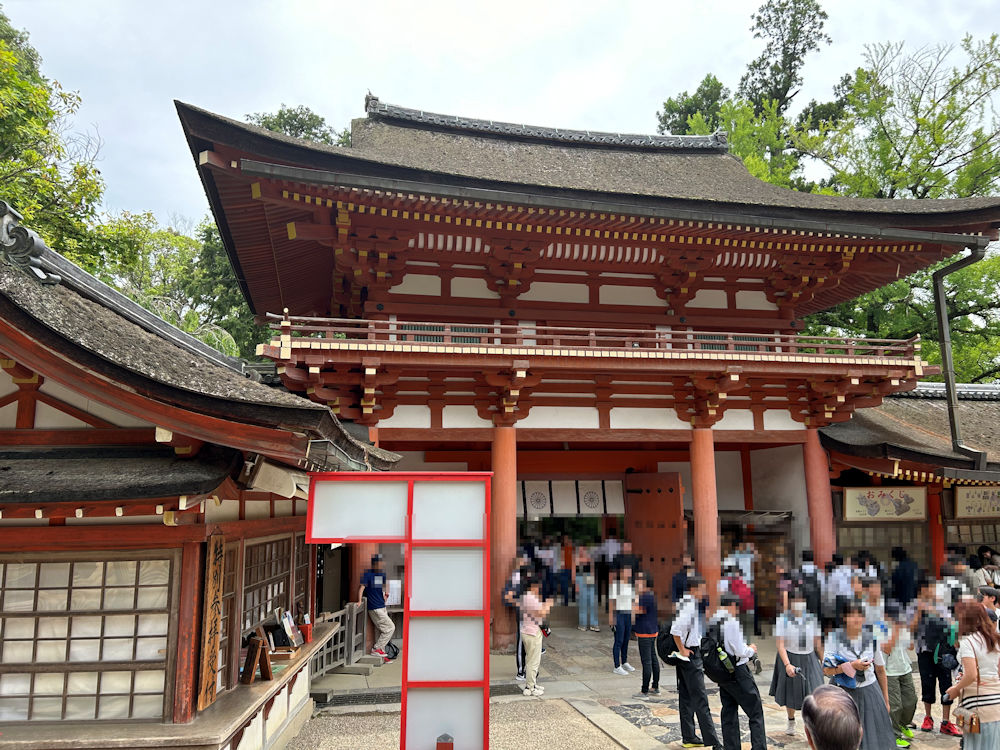
The South Gate of Kasuga Taisha Shinto Shrine, a World Heritage component
We left the Giant Buddha Hall for Sangatsudo, passing by the Bell Tower, built in the early 13th century and also designated as a national treasure. The guide advised us that the bell weighing 26 tons is even older, dating back to when Todaiji was founded. We ascended the gentle stone steps to arrive at a spacious plateau where the Nigatsu-do (Second Month Hall) stands to the left and the Sangatsu-do (Third Month Hall) to the right.
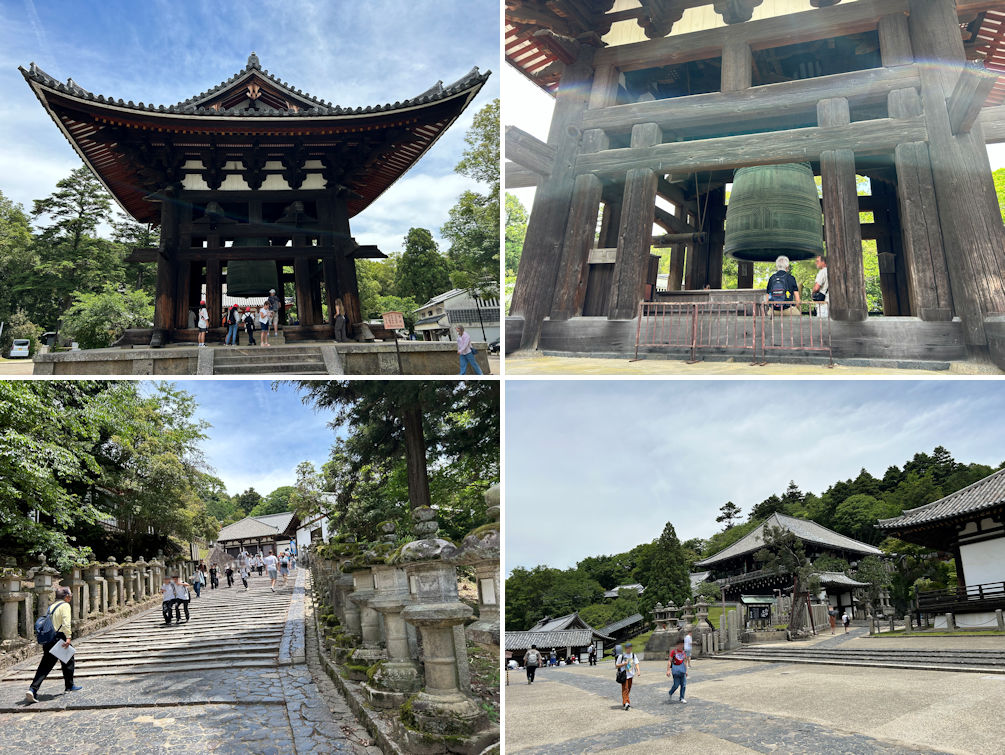
Upper row: The Bell Tower designated as a national treasure (left) and the bell weighing 26 tons (right). Lower row: We ascended the stone steps (left) to arrive at a plateau where the Nigatsu-do and Sangatsu-do are aituated.
Nigatsu-do is so named because of the ritual Shunie performed on the hall
in the second month (Nigatsu) of the lunar calendar. The Shunie, a Buddhist
ritual observed throughout Japan, is not exclusive to Todaiji Temple. Held
annually from March 1st to 14th, it serves a dual purpose: offering repentance
for past transgressions and celebrating the arrival of a new year. At Todaiji,
eleven chosen monks participate in the Shunie, representing the public
in offering repentance to the Eleven-Faced Kannon Bodhisattva, the temple's
main deity. Every night during this period, large torches illuminate the
path of the monks. The sight of the torches illuminating the temple interior
is truly magnificent. For further details about the Shunie at Todaiji Temple,
please refer to their official website.

The Nigatsu-do. One of the stairs leading up to the platform can be seen in the far back.
Nigatsudo Hall, a structure designed specifically for religious ceremonies, features stairs on both sides that lead to an elevated stage. Our guide led us up the right-hand stairs to the stage. The main deity, an Eleven-Faced Kannon Bodhisattva statue, is not open to the public. "No one has ever actually seen it," our guide explained. From the stage, we enjoyed a breathtaking panoramic view of Nara, reminiscent of the stage at Kiyomizu-dera Temple in Kyoto.
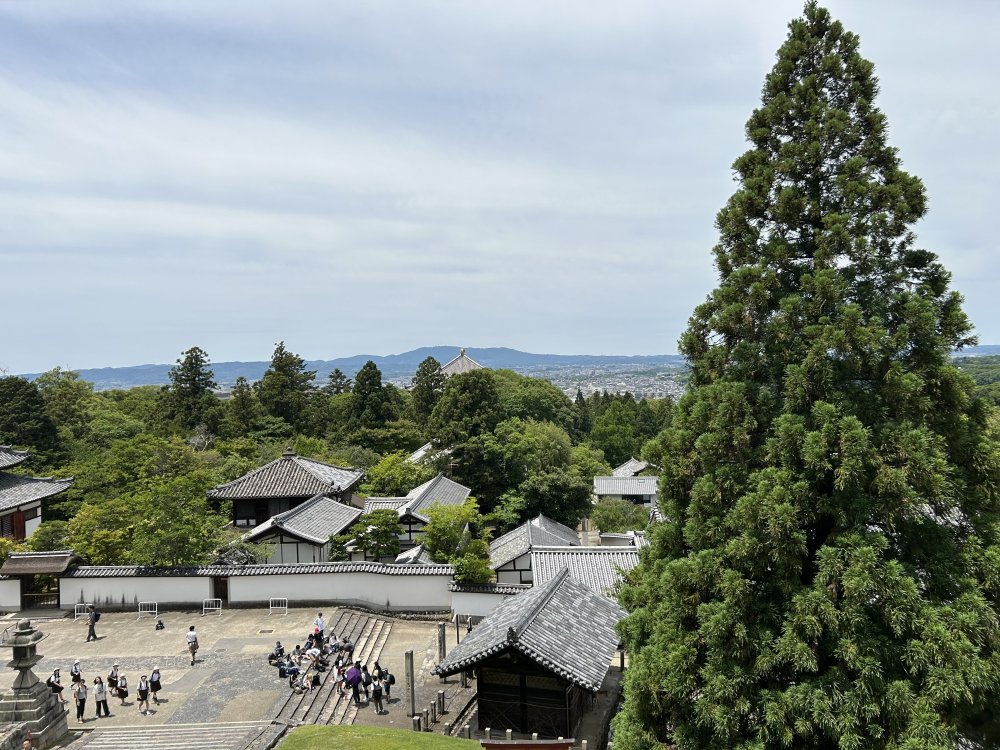
From the stage, we enjoyed a breathtaking panoramic view of Nara, reminiscent of the stage at Kiyomizu-dera Temple in Kyoto.
Descending the staircase on the opposite side, we came to a small hut housing the Wakasa Ido well. One of the most renowned events during Nigatsudo Hall's Shunie ceremony is the omizutori, or "water-drawing ritual," which takes place from late at night on the 12th of March to the early hours of the 13th. During this ritual, water from the Wakasa Ido well is offered to the Eleven-Faced Kannon Bodhisattva. Legend has it that when the Shunie was first performed at Todaiji Temple, Monk Jitchu invited 17,000 Gods from across the country to attend. However, only Onyu Myojin, a deity from Wakasa Province (located north of Kyoto) was delayed, having been engrossed in fishing in a river. As an apology, Onyu Myojin promised to send sacred water from Wakasa to offer to the main deity, and with a prayer, this well miraculously sprang forth. As the story suggests, the hut is of a Shinto structure, a testament to the blending of Shinto and Buddhism (shinbutsu shugo). The current hut, rebuilt in the early 13th century, is designated as an Important Cultural Property..

One of the most renowned events during Nigatsudo Hall's Shunie ceremony is the omizutori, or "water-drawing ritual," which takes place from late at night on the 12th of March to the early hours of the 13th. During this ritual, water from the Wakasa Ido well is offered to the Eleven-Faced Kannon Bodhisattva.
Due to time constraints, we only passed by Sangatsudo, which is next to Nigatsudo. Sangatsudo is officially known as Hokke-do. When viewed from the side, the distinct differences in architectural styles on either side of the building are evident. The left side, dating back to the Nara period, is one of the oldest structures in Todai-ji and houses the principal image of Fukukenjaku Kannon. The right side is a worship hall built at the end of the 12th century when the High Monk Chogen reconstructed Todai-ji. Naturally, it is designated as a National Treasure. We had started from close to Kintetsu Nara Station at 9am, and it was now 11:30am. The tour so far had taken two hours and a half. Our guide suggested we have lunch at a soba restaurant in front of the Hokkedo. It was an ideal timing for lunch as it was a rather warm day, and it would have taken us some time to reach any other restaurant.
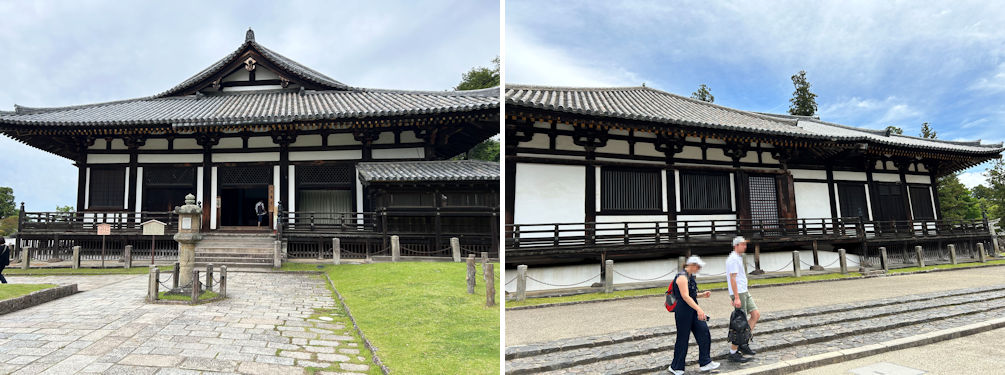
The entrance to the Sangatsu-do (officially the Hokke-do) from the southern side (left). View from the eastern side (right). The left side, dating back to the Nara period, is one of the oldest structures in Todai-ji and houses the principal image of Fukukenjaku Kannon. The right side is a worship hall built at the end of the 12th century when the High Monk Chogen reconstructed Todai-ji.
Following lunch, we headed south along the mountain foot from Sangatsudo, and a building resembling a shrine appeared on the left. This was Tamukeyama Hachiman Shrine. Its origin dates back to the mid-7th century when the Hachiman deity was invited from Usa Hachimangu as the guardian deity of Todai-ji and the Great Buddha upon their construction. After several relocations, it moved to its current location in the 13th century. Hachiman is a war god, and inviting him as the guardian deity of a Buddhist temple reflects the very practice of the syncretism of Shinto and Buddhism (if you wish to know more about Hachimanshin and Usa Hachimanguu, please click here). Unfortunately, the shrine was closed on the day of our visit.
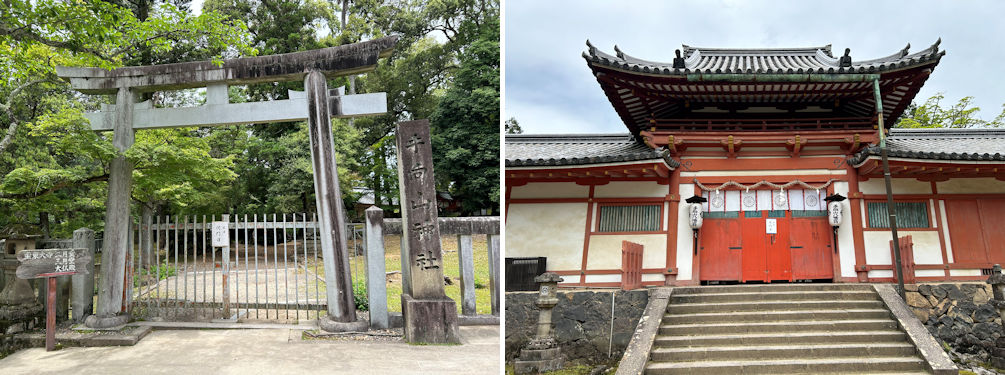
The entrance torii gate to Tamukeyama-hachimangu Shrine (left). The shrine was closed on the day of my visit. It is very rare for Shinto shrines to be closed on a weekly basis. Side of the shrine seen from the path from the Sangatsu-do (right).
I noticed two old buildings across from Tamukeyama-hachimangu Shrine. Judging
from their appearance, I thought they might be built in the Azekura-style
architecture, and upon further investigation, it turned out they were indeed
so. Azekura-style architecture is a unique form in Japanese construction
where triangular timbers are stacked horizontally to support a roof without
the use of pillars, akin to Nordic log houses. Generally, these structures
are built with raised floors. They have origins dating back to warehouses
from the Yayoi period and have been used to store treasures in prestigious
temples and shrines such as the Shosoin at Todaiji Temple. The materials
used typically include coniferous trees such as cedar and cypress. I understand
the photographed building houses the portable shrine of Tamukeyama-hachimangu
Shrine, reportedly relocated from Todaiji Temple.

I understand this Azekura-style building with a raised floor was relocated from another area in Todaiji and houses the portable shrine of Tamukeyama-hachimangu Shrine.
A ten minutes’ walk brought us to a path into Kasuga Taisha Shinto Shrine,
which is also a component property of the UNESCO World Heritage “Historic
Monuments of Ancient Nara” designated in 1998. As described in the shrine’s
website, “Ancient myths tell us that about 1300 years ago when the national
capital was built in Nara, Takemikazuchi-no-mikoto came all the way from
Kashima Shrine (Ibaraki Prefecture) to Mt. Mikasa, which is considered
a holy mountain, to dwell on its summit “Ukigumo-no-mine” for the prosperity
of the nation and happiness of the people. Later on, when Tempyo Culture
flourished, the political leader Fujiwara-no-Nagate built magnificent buildings
on the present site of the shrine as ordained by Empress Shotoku. On November
9, 768, he enshrined several gods here, namely Futsunushi-no-mikoto from
Katori Shrine (Chiba Prefecture), and Amenokoyane-no-mikoto and Himegami
from Hiraoka Shrine (Osaka Prefecture). This is how Kasuga Taisha began".
Kasuga Taisha worships the four deities, Takemikazuchi-no-mikoto, Futsunushi-no-mikoto, Amenokoyane-no-mikoto and Himegami, each with their dedicated temple building in the honden (main shrine building). It is also worth noting that Takemikazuchi-no-mikoto worshipped at Kashima Jingu is the mythical Thunder God as well as God of Swords, and was invited to Kasuga Taisha (It is a common Shinto practice to invite Gods from elsewhere). He arrived at Kasuga Taisha mounted on a sacred deer, which is believed to be the ancestor of the deer in Nara. DNA testing has revealed that the deer in Nara are a distinct species that diverged from Japanese deer around the 8th century, but whether they really are the descendants of the sacred deer at Kashima Jingu has not been established.
(note: Mt. Mikasa is the triangular-shaped mountain (elevation 297m) located in front of Mt. Kasuga (elevation 342m), when viewed eastward from Nara City. Mt. Kasuga has been preserved as a sacred forest of Kasuga Taisha where no hunting or tree-felling has been permitted since 841. The primeval forest also constitutes a World Heritage component property.)
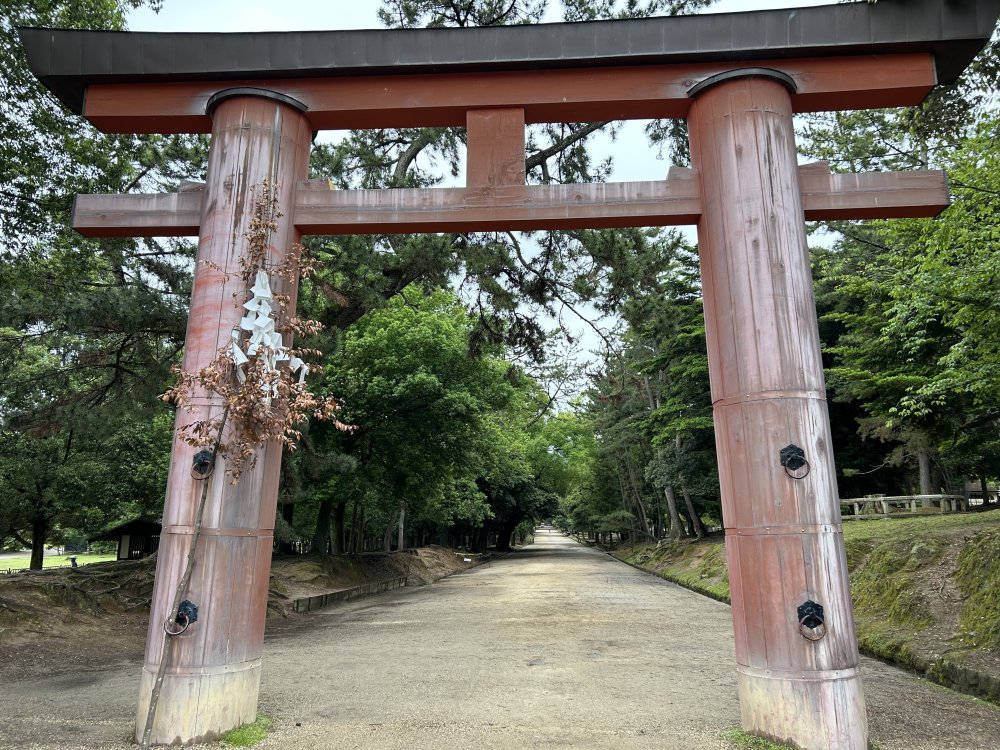 /p>
/p>
The entance torii gate to Kasuga Taisha is located to the south of Todaiji's Nandaimon Gate. There is a long approach to the Honden (main shrine building) in the east.
We made a brief stop at one of the sub-shrines of Kasuga Taisha, Mizuya
Jinja. The name is derived from a small but sacred river Mizuya River flowing
from the mountains. From the Heian era, the deity of the shrine is believed
to dispel disasters and epidemics. Our guide also told us that there is a small rock wedged between the building's foundations, and it is said that praying at this shrine brings about the gift of children.
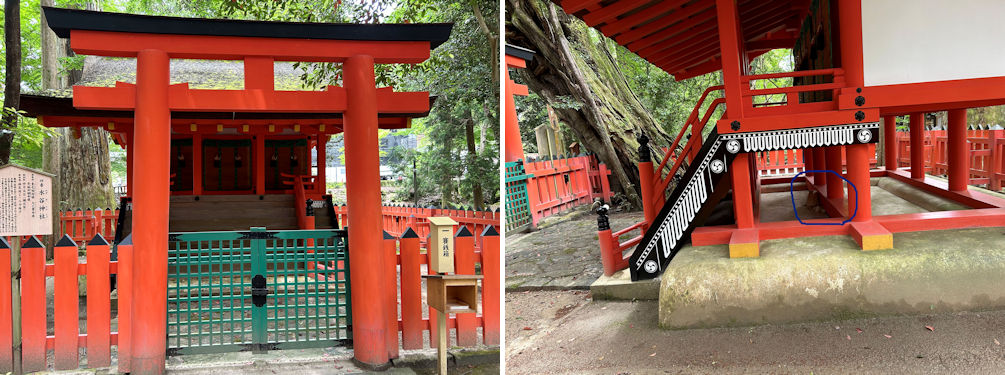
The front side of Mizuya Jinja (left). The sacred rock is marked with a blue circle (right).
Another sub-shrine close by was Hitokotonushi Jinja, worshipping the Hitokotonushi
deity, known for delivering wishes even consisting of one word (hitokoto).
There are a couple of Hitokotonushi Jinjas across Japan. This shrine was
founded in the early Heian era ( late 8th to 9th century) originally within
the temple grounds of Kofukuji, and relocated to Kasuga Taisha in the Meiji
era. As we approached the Honden (main shrine building), there was a monument
of a waka poem by Abe no Nakamaro, dispatched as a foreign student to Tang
China and unable to return to Japan, expressing his wish to return to Japan,
Kasuga in particular. His poem has been translated "As I look out
into the vast expanse, can this be the same moon that I saw rise in Kasuga
behind Mount Mikasa?" by composing a poem about the Kasuga area.
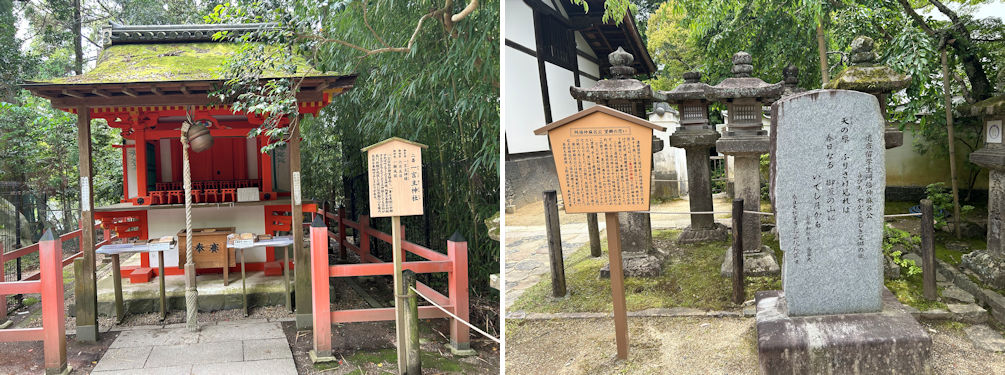
The Hitokotonushi Jinja (left), and the monument of Abe no Nakamaro's waka poem (right).
We came to the Honden (main temple building). Kasuga Taisha is famous for
its 3,000 stone and bronze lanterns, contributed from all parts of Japan
since the late Heian period to the present day by nobles, samurai, and
commoners who revere the deities of Kasuga. These lanterns were offered
with prayers for family safety, business prosperity, long-lasting military
fortune, and the wellbeing of ancestors' spirits. The lanterns of Kasuga
are not only numerous but also significant as historical artifacts. Over
60% of the pre-Muromachi era (14th to 16th century) lanterns that still
exist are at Kasuga Taisha Shrine. We then took the Community Bus from
the bus terminal to Nara Palace Site Historical Park (Heijokyo-ato).
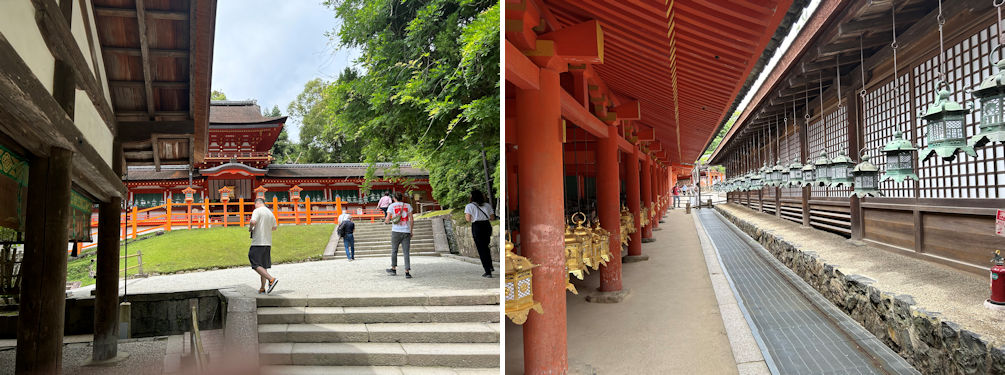
The Honden of Kasuga Taisha (left) and its numerous bronze lanterns (right).